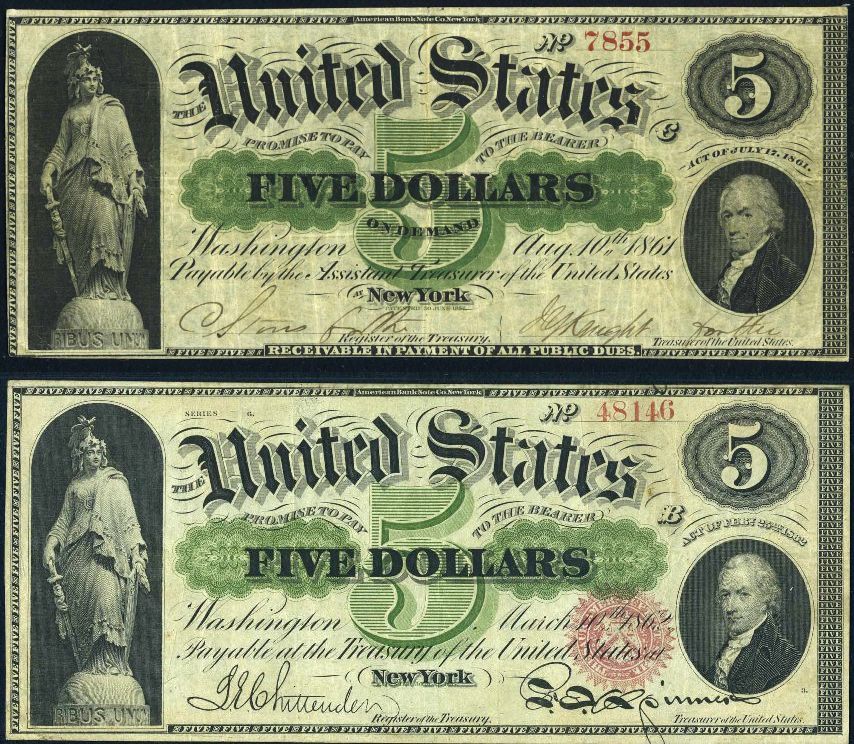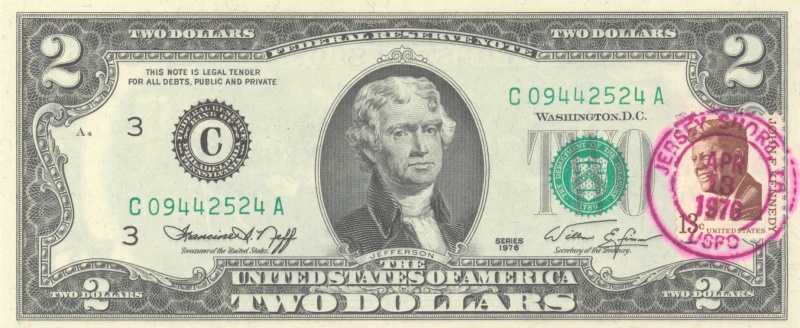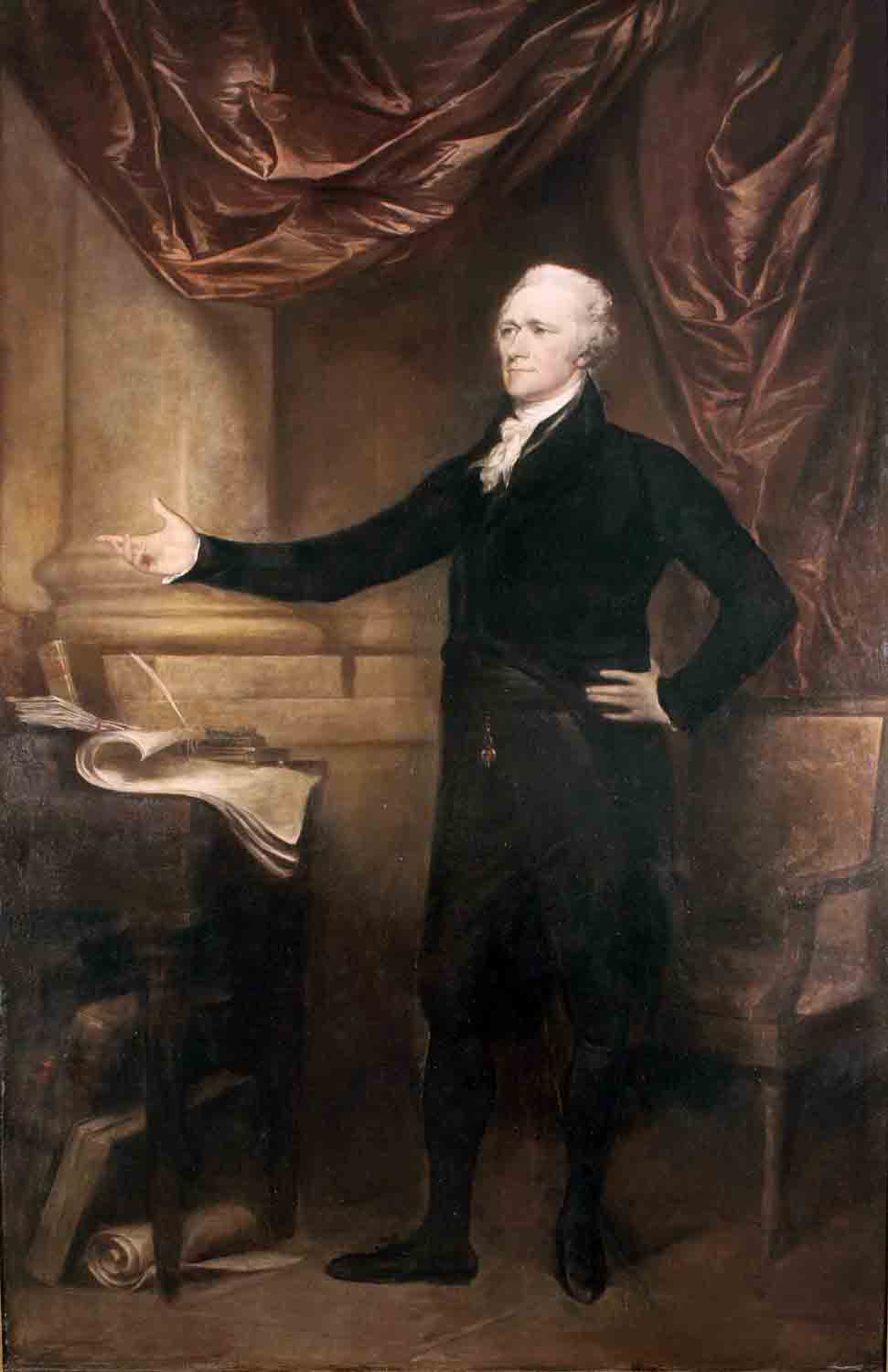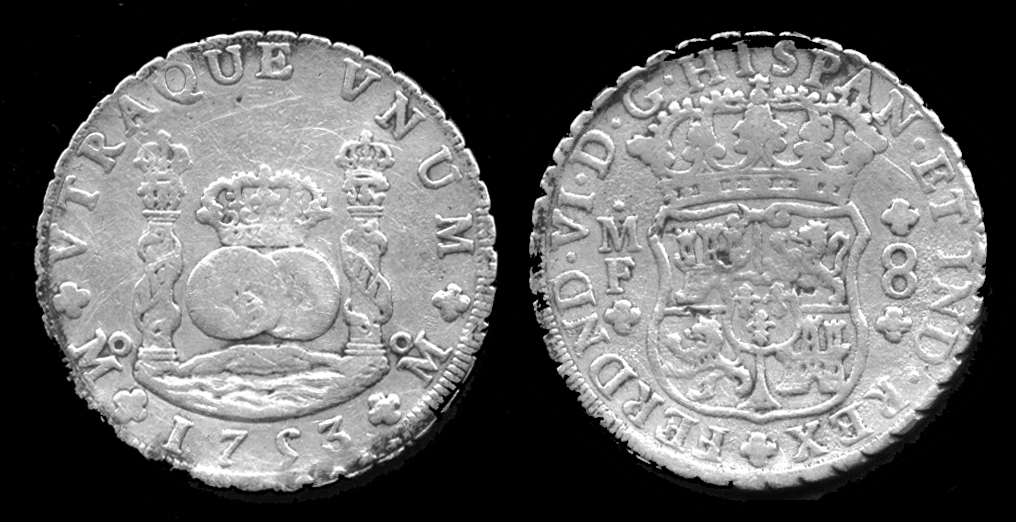|
US$
The United States dollar (symbol: $; code: USD; also abbreviated US$ or U.S. Dollar, to distinguish it from other dollar-denominated currencies; referred to as the dollar, U.S. dollar, American dollar, or colloquially buck) is the official currency of the United States and several other countries. The Coinage Act of 1792 introduced the U.S. dollar at par with the Spanish silver dollar, divided it into 100 cents, and authorized the minting of coins denominated in dollars and cents. U.S. banknotes are issued in the form of Federal Reserve Notes, popularly called greenbacks due to their predominantly green color. The monetary policy of the United States is conducted by the Federal Reserve System, which acts as the nation's central bank. The U.S. dollar was originally defined under a bimetallic standard of (0.7735 troy ounces) fine silver or, from 1837, fine gold, or $20.67 per troy ounce. The Gold Standard Act of 1900 linked the dollar solely to gold. From 1934, its e ... [...More Info...] [...Related Items...] OR: [Wikipedia] [Google] [Baidu] |
United States One-hundred-dollar Bill
The United States one-hundred-dollar bill ($100) is a denomination of United States currency. The first United States Note with this value was issued in 1862 and the Federal Reserve Note version was launched in 1914, alongside other denominations. Statesman, inventor, diplomat, and American founding father Benjamin Franklin has been featured on the obverse of the bill since 1914. On the reverse of the banknote is an image of Independence Hall in Philadelphia, which has been used since 1928. The bill is the largest denomination that has been printed and circulated since July 13, 1969, when the larger denominations of , , , and were retired. As of December 2018, the average life of a bill in circulation is 22.9 years before it is replaced due to wear. The bills are also commonly referred to as "Bens", "Benjamins", or "Franklins", in reference to the use of Benjamin Franklin's portrait by the French painter Joseph Duplessis on the denomination, as "C-Notes" or "Century Notes", b ... [...More Info...] [...Related Items...] OR: [Wikipedia] [Google] [Baidu] |
United States Note
A United States Note, also known as a Legal Tender Note, is a type of paper money that was issued from 1862 to 1971 in the U.S. Having been current for 109 years, they were issued for longer than any other form of U.S. paper money. They were known popularly as "greenbacks", a name inherited from the earlier greenbacks, the Demand Notes, that they replaced in 1862. Often termed Legal Tender Notes, they were named United States Notes by the First Legal Tender Act, which authorized them as a form of fiat currency. During the early 1860s the so-called ''second obligation'' on the reverse of the notes stated: By the 1930s, this obligation would eventually be shortened to: They were originally issued directly into circulation by the U.S. Treasury to pay expenses incurred by the Union during the American Civil War. During the next century, the legislation governing these notes was modified many times and numerous versions were issued by the Treasury. United States Notes tha ... [...More Info...] [...Related Items...] OR: [Wikipedia] [Google] [Baidu] |
United States Two-dollar Bill
The United States two-dollar bill ($2) is a current denomination of United States currency. A portrait of Thomas Jefferson, the third president of the United States (1801–1809), is featured on the obverse of the note. The reverse features an engraving of the ''circa'' 1818 painting ''Declaration of Independence'' by John Trumbull. Throughout the $2 bill's pre-1929 life as a large-sized note, it was issued as a United States Note, National Bank Note, Silver Certificate, Treasury or "Coin" Note, and Federal Reserve Bank Note. When U.S. currency was changed to its current size in 1928, the $2 bill was redesigned and issued only as a United States Note. Production continued until , when United States Notes were phased out, and the $2 denomination was discontinued until 1976, when it was reissued as a Federal Reserve Note with a new reverse design. As a result of banking policies with businesses that have resulted in low production numbers due to lack of use, two-dollar bills ... [...More Info...] [...Related Items...] OR: [Wikipedia] [Google] [Baidu] |
Large Denominations Of United States Currency
Large denominations of United States currency greater than were circulated by the United States Treasury until 1969. Since then, U.S. dollar banknotes have only been issued in seven denominations: $1, $2, $5, $10, $20, $50, and $100. Overview and history Large-denomination currency (i.e., banknotes with a face value of or higher) had been used in the United States since the late 18th century. The first note was issued by North Carolina, authorized by legislation dated May 10, 1780. Virginia quickly followed suit and authorized the printing of and notes on October 16, 1780 and notes on May 7, 1781. High-denomination treasury notes were issued, for example during the War of 1812 ($1,000 notes authorized by an act dated June 30, 1812). During the American Civil War Confederate currency included and notes. The earliest (1861) federal banknotes included high-denomination notes such as three-year interest-bearing notes of , , and , authorized by Congress on July 17, 18 ... [...More Info...] [...Related Items...] OR: [Wikipedia] [Google] [Baidu] |
United States Ten-dollar Bill
The United States ten-dollar bill ($10) is a Denomination (currency), denomination of U.S. currency. The obverse of the bill features the portrait of Alexander Hamilton, who served as the first U.S. Secretary of the Treasury. The Obverse and reverse, reverse features the U.S. Treasury Building. All $10 bills issued today are Federal Reserve Notes. As of December 2018, the average life of a $10 bill in Circulation (currency), circulation is 5.3 years before it is replaced due to wear. Ten-dollar bills are delivered by Federal Reserve Banks in yellow straps. The source of the portrait on the $10 bill is John Trumbull's 1805 painting of Hamilton that belongs to the portrait collection of New York City Hall. The $10 bill is unique in that it is the only denomination in circulation in which the portrait faces to the left. It also features one of two non-presidents on currently issued U.S. bills, the other being Benjamin Franklin on the United States one hundred-dollar bill, $100 bill. ... [...More Info...] [...Related Items...] OR: [Wikipedia] [Google] [Baidu] |
United States Twenty-dollar Bill
The United States twenty-dollar bill ($20) is a denomination of U.S. currency. A portrait of Andrew Jackson, the seventh U.S. president (1829–1837), has been featured on the obverse of the bill since 1928; the White House is featured on the reverse. As of December 2018, the average life of a $20 bill in circulation is 7.8 years before it is replaced due to wear. About 11% of all notes printed in 2009 were $20 bills. Twenty-dollar bills are delivered by Federal Reserve Banks in violet straps. History Large-sized notes * The back is printed green. * The back is different, with several small variations extant. * The reverse has a $20 gold coin and various abstract elements. The back is orange. * * The back design is green. * * The back design is black. * The back is orange and features an eagle. * The front is similar, but the back is different and printed in brown. * * Two different backs exist both with abstract designs. * The front features Hugh McCulloch, and ... [...More Info...] [...Related Items...] OR: [Wikipedia] [Google] [Baidu] |
United States One-dollar Bill
The United States one-dollar bill ($1), sometimes referred to as a single, has been the lowest value denomination of United States paper currency since the discontinuation of U.S. fractional currency notes in 1876. An image of the first U.S. president (1789–1797), George Washington, based on the '' Athenaeum Portrait'', a 1796 painting by Gilbert Stuart, is currently featured on the obverse, and the Great Seal of the United States is featured on the reverse. The one-dollar bill has the oldest overall design of all U.S. currency currently being produced (The current two-dollar bill obverse design dates from 1928, while the reverse appeared in 1976). The obverse design of the dollar bill seen today debuted in 1963 (the reverse in 1935) when it was first issued as a Federal Reserve Note (previously, one dollar bills were Silver Certificates). A dollar bill is composed of 25% linen and 75% cotton. That blend makes the notes more difficult to counterfeit compared to pap ... [...More Info...] [...Related Items...] OR: [Wikipedia] [Google] [Baidu] |
Dollar Coin (United States)
The dollar coin is a United States coin with a face value of one United States dollar. Dollar coins have been minted in the United States in gold, silver, and base metal versions. Dollar coins were first minted in the United States in 1794. While true gold dollars are no longer minted, the Sacagawea, Presidential, and American Innovation dollars are sometimes referred to as golden dollars because of their color. As with several other denominations of U.S. coinage, golden dollars are similar in diameter and color to their Canadian counterpart (known as the "loonie," which predates the Sacagawea dollar by thirteen years). However, unlike the 11-sided Canadian dollar coins, U.S. "golden dollar" coins are round. Dollar coins have never been popular in circulation since inception. Despite efforts by the government to promote their use to save the cost of printing one-dollar bills, such as the Presidential $1 Coin Program, most Americans currently use the bill. For this reason, s ... [...More Info...] [...Related Items...] OR: [Wikipedia] [Google] [Baidu] |
Two-cent Piece (United States)
The two-cent piece was produced by the Mint of the United States for circulation from 1864 to 1872 and for collectors in 1873. Designed by James B. Longacre, there were decreasing mintages each year, as other minor coins such as the nickel proved more popular. It was abolished by the Mint Act of 1873. The economic turmoil of the American Civil War caused government-issued coins, even the non-silver Indian Head cent, to vanish from circulation, hoarded by the public. One means of filling this gap was private token issues, often made of bronze. The cent at that time was struck of a copper-nickel alloy, the same diameter as the later Lincoln cent, but somewhat thicker. The piece was difficult for the Philadelphia Mint to strike, and Mint officials, as well as the annual Assay Commission, recommended the coin's replacement. Despite opposition from those wishing to keep the metal nickel in the coinage, led by Pennsylvania Congressman Thaddeus Stevens, Congress passed the Coinage ... [...More Info...] [...Related Items...] OR: [Wikipedia] [Google] [Baidu] |
Nickel (United States Coin)
A nickel is a five- cent coin struck by the United States Mint. Composed of cupronickel (75% copper and 25% nickel), the piece has been issued since 1866. Its diameter is 0.835 inches (21.21 mm) and its thickness is 0.077 inches (1.95 mm). The silver half dime, equal to five cents, was issued from 1792 to 1873 before today's cupronickel version. The American Civil War caused economic hardship, driving gold and silver from circulation; in response, in place of low-value coins, the government at first issued paper currency. In 1865, Congress abolished the five-cent fractional currency note after Spencer M. Clark, head of the Currency Bureau (today the Bureau of Engraving and Printing), placed his own portrait on the denomination. After the successful introduction of two-cent and three-cent pieces without precious metal, Congress also authorized a five-cent piece consisting of base metal; the Mint began striking this version in 1866. The initial design of ... [...More Info...] [...Related Items...] OR: [Wikipedia] [Google] [Baidu] |
Dollar Sign
The dollar sign, also known as peso sign, is a symbol consisting of a capital " S" crossed with one or two vertical strokes ($ or ), used to indicate the unit of various currencies around the world, including most currencies denominated " peso" and " dollar". The explicitly double-barred sign is called cifrão. The sign is also used in several compound currency symbols, such as the Brazilian real (R$) and the Nicaraguan córdoba (C$). The one- and two-stroke version are often considered mere stylistic (typeface) variants, although in some places and epochs one of them may have been specifically assigned, by law or custom, to a specific currency. The Unicode computer encoding standard defines a single code for both. In most English-speaking countries that use that symbol, it is placed to the left of the amount specified, e.g. "$1", read as "one dollar". History Use for the Spanish American peso in the late 1700s The symbol appears in business correspondence in the 1 ... [...More Info...] [...Related Items...] OR: [Wikipedia] [Google] [Baidu] |
Three-cent Nickel
The copper-nickel three-cent piece, often called a three-cent nickel piece or three-cent nickel, was designed by US Mint Chief Engraver James B. Longacre and struck by the United States Bureau of the Mint from 1865 to 1889. It was initially popular, but its place in commerce was supplanted by the five-cent piece, or nickel. With precious metal federal coinage hoarded during the economic turmoil of the American Civil War, including the silver three-cent piece, and even the copper-nickel cent commanding a premium, Congress issued paper money in denominations as small as three cents to replace the hoarded coins in commerce. These small slips of paper became ragged and dirty, and the public came to hate " shinplasters". After the issuance in 1864 of a lighter bronze cent and a two-cent piece of that metal, both of which circulated freely, there were proposals for a three-cent piece in copper-nickel to replace the three-cent note. The advocates were led by Pennsylvania industriali ... [...More Info...] [...Related Items...] OR: [Wikipedia] [Google] [Baidu] |








_(obv).jpg)


